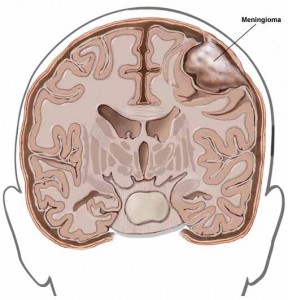Mary Tyler Moore to Undergo Surgery for Benign Brain Tumor

Veteran actress Mary Tyler Moore will be undergoing surgery to remove a benign brain tumor called a meningioma. Moore’s rep told People magazine:
“At the recommendation of her neurologist, who has been monitoring this for years, and a neurosurgeon, Mary decided to proceed with this fairly routine procedure.”
Moore, 73, is best known for her iconic roles as Laura Petrie on the Dick Van Dyke Show(1961–66), and Mary Richards on the Mary Tyler Moore Show(1970–77). She was also nominated for an Academy Award for her role in Ordinary People. Moore has written two memoirs. The first, After All, released in 1995, in which she acknowledged that she is an alcoholic. The next, Growing Up Again: Life, Loves, and Oh Yeah, Diabetes, was released on April 1, 2009, and focuses on living with type 1 diabetes.
 The brain is covered by three layers of membrane, called the meninges. The outer layer which is closest to the inside of the skull, is a thick,fibrous membrane called the dura mater.
The brain is covered by three layers of membrane, called the meninges. The outer layer which is closest to the inside of the skull, is a thick,fibrous membrane called the dura mater.
The delicate, spiderweb-like (hence the name) arachnoid membrane lies beneath the dura and surrounds the brain and spinal cord.
Unlike the third layer, the pia mater- which is in contact with the brain surface, the arachnoid membrane does not dip down into the folds of the brain, and is separated from the pia mater by the subarachnoid space.
A meningeal tumor, also called a meningioma, forms in the meninges .
It is the most common type of all primary brain and central nervous system (CNS) tumors. It can form from different types of brain or spinal cord cells.
A meningioma is most common in adults between the ages of 40 and 70.
According to the Brain Science Foundation, this year, approximately 21,270 people in the United States will be diagnosed with a meningioma, and current estimates suggest more than 206,900 Americans are living with a meningioma or have been treated for a meningioma.
Types of meningeal tumors include the following:
 Meningioma (grade I): A grade I meningioma is the most common type of meningeal tumor. A grade I meningioma is a slow-growing, benign tumor that forms most often in the dura mater. It is most common in women. Because of the slow growth of meningiomas, depending upon where it is located, a meningioma may reach a relatively large size before it causes symptoms.
Meningioma (grade I): A grade I meningioma is the most common type of meningeal tumor. A grade I meningioma is a slow-growing, benign tumor that forms most often in the dura mater. It is most common in women. Because of the slow growth of meningiomas, depending upon where it is located, a meningioma may reach a relatively large size before it causes symptoms.
Meningioma (grade II and III): This is a rare, malignant meningeal tumor. It grows quickly and is likely to spread within the brain and spinal cord. A grade III meningioma is most common in men.
The only known predisposing factors associated with meningiomas are exposure to radiation, and certain genetic disorders (e.g. neurofibromatosis).
Symptoms of a meningioma may include:
- Morning headache or headache that goes away after vomiting.
- Frequent nausea and vomiting.
- Vision, hearing, and speech problems.
- Loss of balance and trouble walking.
- Weakness on one side of the body.
- Unusual sleepiness or change in activity level.
- Unusual changes in personality or behavior.
- Seizures.
For more information, click here to go to the Resounding Health Casebook on benign brain tumors.
UPDATE: Ms. Moore underwent a 4 hour procedure to remove the meningioma and according to her representative:
“According to her surgeon, she tolerated the procedure without difficulty and is recovering nicely with her husband at her bedside.”
The tumor was completely removed and no further treatment will be necessary. Here’s to a speedy recovery!



























0 comments